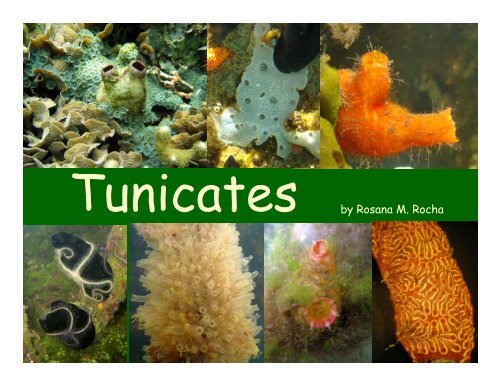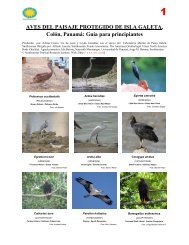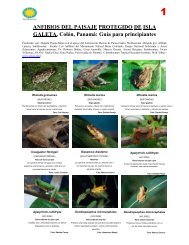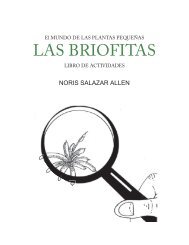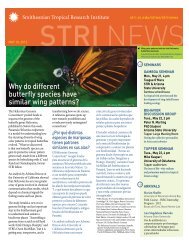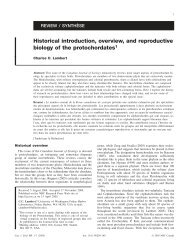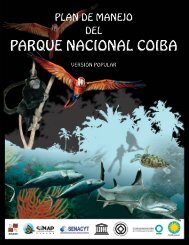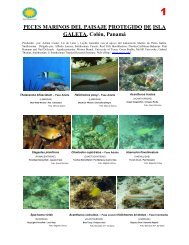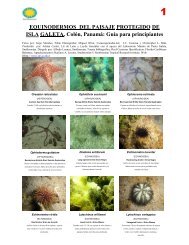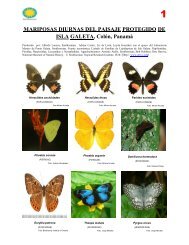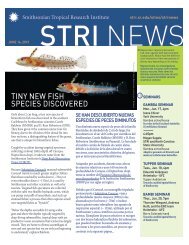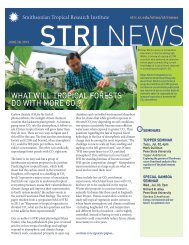Create successful ePaper yourself
Turn your PDF publications into a flip-book with our unique Google optimized e-Paper software.
<strong>Tunicates</strong> <strong>by</strong><br />
<strong>Rosana</strong> M. <strong>Rocha</strong>
<strong>Tunicates</strong> are known as sea squirts …<br />
….because they<br />
circulate i l water<br />
inside.<br />
When you take them out of the<br />
water t they th contract t t and d squirt s i t you!!<br />
!!
<strong>Tunicates</strong> are diverse<br />
Four newly discovered species<br />
from Bocas are now being<br />
described (two of them in these<br />
pictures).<br />
There are 2,500 named<br />
species p of tunicates, , 140 of<br />
them live in the Caribbean.<br />
There are around 60 species in<br />
the Bocas del Toro region.
<strong>Tunicates</strong> are useful<br />
<strong>Tunicates</strong> are cultivated and eaten in many countries<br />
including Japan, Korea, Chile and France.
<strong>Tunicates</strong> help fight cancer<br />
Because they do not have any<br />
external skeleton, skeleton tunicates<br />
use chemicals to protect<br />
themselves.<br />
Some tunicate chemicals are<br />
proven to act aga against nst cancer<br />
cells. Others can kill bacteria<br />
and fungus resistant to<br />
antibiotics antibiotics.<br />
Th h i l E t i idi ET743 f E t i idi<br />
The chemical Ecteinascidin ET743 from Ecteinascidia<br />
turbinata, has been shown to act against sarcomas.
… but they also cause trouble!<br />
Some species are invasive<br />
and cause problems for<br />
aquaculture.<br />
They grow on mussel<br />
and oyster shells,<br />
compete with them<br />
for space and<br />
increase the weight<br />
of the culture. Billions<br />
of dollars are wasted<br />
just cleaning the<br />
shells!
<strong>Tunicates</strong> act like plants<br />
Many tropical species have<br />
single-celled algae living as<br />
simbionts inside their<br />
tissues.<br />
Most tunicate species p live<br />
permanently attached to a<br />
substrate.<br />
They are also like plants because the have cellulose<br />
fibers in the tunic tissue that covers their body.
Other tunicate facts<br />
The tunic that cover their body is a<br />
living tissue with blood vessels. It is<br />
equivalent q to our connective tissue<br />
underneath the skin. But they have<br />
it outside the skin!!<br />
<strong>Tunicates</strong> are the only animals that<br />
reverse their blood circulation.<br />
Their heart is tubular u u and they y have<br />
two pace-makers which take turns.
Other tunicate facts<br />
<strong>Tunicates</strong> are the<br />
animal m group g p most m<br />
closely related to<br />
vertebrates.<br />
Their larva is called tadpole and has chordate features,<br />
like a tail with a stiff rod called a notochord and a nerve<br />
cord like our spinal cord.
We need more biologists studying<br />
tunicates tunicates…<br />
Photos <strong>by</strong> Charles and Gretchen Lambert<br />
of f the th Tunicate T i t course in i 2006<br />
… we are training them at the Bocas del Toro Research Station


